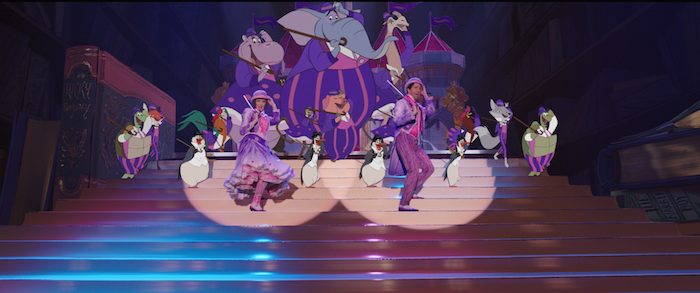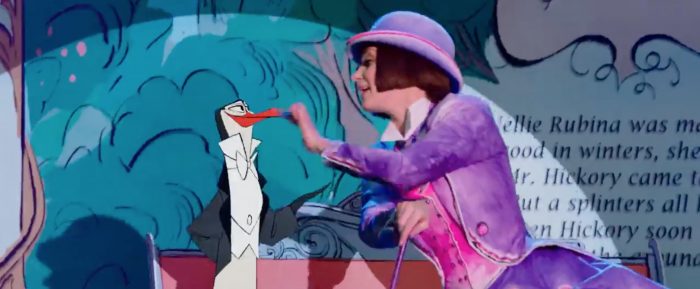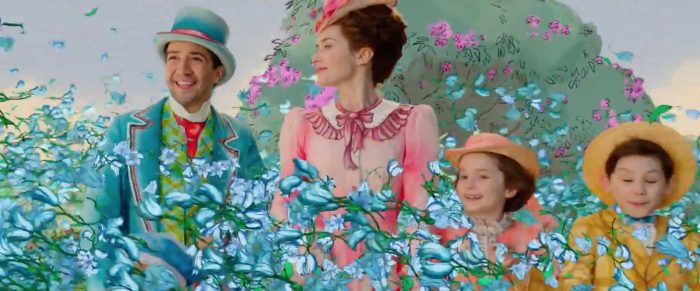'Mary Poppins Returns' Director Rob Marshall On That Live-Action/Animation Scene, Nostalgia, And His Favorite Easter Egg [Interview]
If you're familiar with Einstein's Theory of Relativity, you know that depending on the circumstances, 10 minutes can seem like it lasts forever or it can go by in the blink of an eye. When speaking with talent at a press junket, it regularly feels like the latter – which is why, when I spoke with Mary Poppins Returns director/co-choreographer Rob Marshall, I didn't bother asking a wide range of questions that tried to cram in anecdotes from the entire production. Instead, I mostly kept the focus on one big stretch of the movie: the scenes in which live-action and animation interact with each other as Mary Poppins (Emily Blunt), Jack (Lin-Manuel Miranda) and the Banks children travel into a Royal Doulton bowl. Read on for our full Rob Marshall interview, in which he gives us insight about how those scenes came together, touches on the idea of nostalgia, and reveals his favorite easter egg in the new sequel.

I'd like to focus on the live-action/animation hybrid scenes. I know you wanted to include those as a nod to the original, but tell me about the actual process of shooting that big dance scene.
Gosh, it's so complicated because in addition to live actors, I also wanted to make sure that myself and John DeLuca, who choreographed it, controlled the rest of the dance. For instance, the flamingos that are dancing, that's something we choreographed with women to act as flamingos. Or the penguins, we had wonderful dancers that we worked with to create the penguins' work. Because you're working with children, as well, there were a lot of things we had to do so they could imagine – as an example, we had a huge pole with a giraffe's head that would go by so they would have the same eyeline and they could see what that is. We had a lot of storyboards and a lot of pre-vis and that kind of thing, and we communicated all of that to the actors so they would understand what it was. But we also had reference actors, so we had men in green playing the coachman, playing the horse, playing the wolf, all those things. So they could interact with real people because they're playing real scenes with animated characters. It was such a challenge, but it was my favorite part of the whole making of the film.
Was that the most daunting part of the movie for you?
It was, because I was thinking, "I don't know how to do this. I know musicals, I know movies, I know visual effects, I know all of that, but how do you do this?" So it really helped that we had a big, huge workshop that we did on the Disney lot on the Hyperion bungalow, which was perfect because it's from the original Disney studios. We all met there – it was a series of animators from Pixar, and also from Walt Disney Animation, our wonderful animation supervisor Jim Capobianco was in charge, and [the writers and composers] – we were all there working together with these animators who came in with their pads of paper and their pencils and their water colors and everything. They were literally creating imagery. I'll never forget, one animator was sketching and said, "I'd love to show you something," and he showed me [Mary Poppins'] parasol spinning and turning into the music hall tent. I thought that was the most genius thing I've ever seen. I said, "Well, that's in the movie!" We put that right up on the board. We kind of created with all of these wonderful minds in the room. It was incredible.
Previously you've said that some animators came out of retirement to help out with this. Can you tell me more about that?
Yes, they did. Because it's somewhat of a lost art. We were looking for the best in the business, and they were retired. Over sixty-whatever. So many of them came out of retirement to help us. But what was interesting was, in addition to them, there were a lot of twenty-somethings who were interested in the classic, old-school hand-drawn animation and want to learn that, who are more interested in that than some of the computer generated stuff. So all of a sudden, there we were with over-sixtys and twenties working in the same space. But it was very exciting, I think, for everybody involved, because when do you get a chance to do this?

When our reporter spoke with Emily Blunt on the set, she said that the dancing was the most challenging aspect of the shoot for her. Looking back on your experience, did it same that way for you on your end?
Not for me, because I'm a dancer and a choreographer, so that actually is something that's in my blood. But I will say that it was exciting to work with Lin and Emily and really tailor-make dances for them and for their strengths. I know it's newer for Emily. When's the last time she got to be in a production number and be lifted by twenty-five men or something? That's very rare. She loved it, but she also knew it was incredibly hard. But we had over two months of rehearsal where we drilled it and worked and got better, and were terrible and got better. That's really what we were there to do.
How long did it take to film that portion of the movie?
I think the two big dances for her that she felt were the most complicated were the animation one, that took about a week, and then the "Trip a Little Light Fantastic," the big production number with all the men. The leeries, our lamplighters. That took over a week. It just takes time because you're doing so many different pieces of it. But it was thrilling.
The live-action/animation hybrid sequence, it sort of seemed like that was the part of the film where you could sneak in some winks to older audiences. One of the verses in "The Cover is Not the Book" song, if I'm not mistaken, is about a tree being impregnated.
Yes, exactly! Well, these are all stories from P.L. Travers.
Really?
Nellie-Rubina is a character, we worked from the P.L. Travers chapters in her stories. So that was really fun. But the thing is, we were in an English music hall. We know it's always saucy there. It's a little risqué. We wanted to do that in the best possible way we could without going too far. But that's what happens in English music halls, it's part of the tradition.
Right, and Emily comes out and does a little hip thrust when she has a different costume on.
Oh yeah, I never thought of that except as a classic music hall step. We weren't going that far. (laughs)

Did Lin write his rap portion of that song?
No. Marc [Shaiman] and Scott [Whitman] wrote it for him. The great thing is, Lin was cast, Emily was cast, Meryl Streep, Ben Whishaw, they were all cast before the writing started, so they were able to write for them. Lin was really interested and excited to not be a writer on this, to just be a writer. They're very clever lyricists too, and they thought they could write this music hall patter for Lin because he's so good at that. So that was a little tour-de-force for him, but they wrote that.
That was a great stretch of performance from him. You were mentioning your background in choreography – tell me about the choreography in this movie. What was the most challenge aspect for you?
Well, it's interesting. You would think it would be the big, huge production number, "Trip a Little Light Fantastic," but it actually wasn't. It was the underwater sequence that was the most complicated because we were trying to choreograph on wires – similar also with the balloon number, too – and trying to create choreography when they're up in the air. It's more complicated because you're involving visual effects, too. So you have less control than you normally do when everybody's on the ground. So that was actually the most complicated, I think.
I'm interested in the idea of nostalgia in our culture right now. We're constantly surrounded – whether it's Stranger Things, which is looking back on the '80s – we seem to be inundated with a lot of nostalgic stuff in our pop culture. For you, you've adapted a lot of older properties and things like that, so what is your relationship with nostalgia and how do you think Mary Poppins Returns fits into the idea of nostalgia as it exists right now?
Yes, I think nostalgia plays a huge part in this film. It had to, because it plays into my personal feelings about the film. I love the original film so much, it's definitely in the fabric of this film. I had to be careful not to overdo it, either. There had to be places where there's an homage here, an homage there, or an Easter egg there, and those were placed very carefully – and careful not to overuse, either, because then it becomes a rehash or something. But do it in a very respectful way and a fun way for people like me. I used myself as a barometer the entire time. I said, "What would I want to see? They're going through the attic, I'd love to see him pick up the snow globe from 'Feed the Birds.' I know people will get that." And of course, the kite plays a huge part in it. We are the extension of that film. We're the sequel, so you want to take some things from it and then of course create your own material as well.
What is your favorite of those easter eggs you were just talking about? Are there any that are more hidden in the background that you enjoyed placing in there?
I don't think a lot of people know that the original young Jane is in the film, Karen Dotrice. She bumps into Michael as he's running to work. She's just a woman asking for an address, and that's the original Jane. She says something that's very sweet that just a few people will get. When she asks for directions and they say, "It's just next door," she says, "Many thanks, sincerely." Which is the end of her song, "many thanks, sincerely...Jane and Michael Banks." Exactly. So that's a fun one.
***
Mary Poppins Returns opens in theaters on December 19, 2018.
